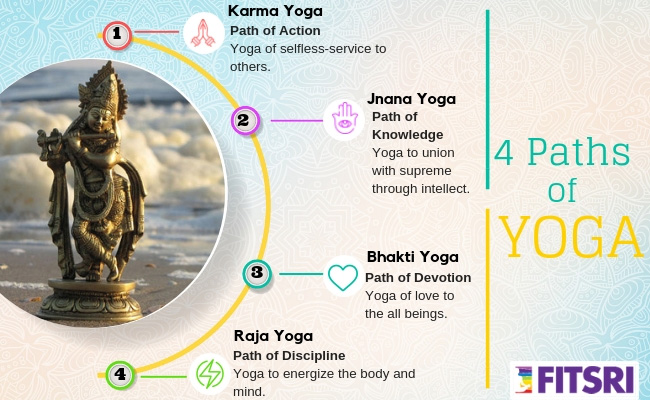
Within the huge tapestry of yogic philosophy, the Bhagavad Gita, a revered textual content in Hinduism, serves as a guiding gentle. On this textual content, Lord Krishna talks in regards to the secrets and techniques of non secular development by way of the lens of 4 paths of yoga.
On this article, we are going to perceive these 4 paths of yoga, also known as “the 4 sorts of yoga in Hinduism.” Every of those paths, Karma Yoga, Jnana Yoga, Bhakti Yoga, and Raja Yoga, gives a novel method to self-realization, catering to totally different persona varieties and non secular inclinations. Collectively, they supply a complete roadmap for people in search of to harmonize their internal and outer worlds.
What Are the 4 Paths of Yoga?
The 4 paths of yoga, also known as “the 4 sorts of yoga in Hinduism,” are the foundational routes to non secular development and self-realization. The 4 paths of yoga are: Karma Yoga, Bhakti Yoga, Rāja Yoga and Jñāna Yoga. They’re outlined within the Bhagavad Gita, a sacred Hindu scripture, and provide distinct approaches to attaining a harmonious union with the divine.
Objective: The first function of 4 paths of yoga is to information people on their journey to self-realization and non secular enlightenment. Every path caters to totally different persona varieties and temperaments, offering a personalised path to internal transformation.
Origins: The idea of the 4 paths of yoga originated from historical Hindu philosophy and scriptures, with the Bhagavad Gita serving as a pivotal textual content that elucidates these paths. They symbolize the varied methods people can navigate the complexities of life and the thoughts to achieve non secular awakening.
Essence in Yoga: These paths type the very essence of yoga philosophy. They provide a complete framework for people to transcend the restrictions of the fabric world and join with their larger selves. Whether or not by way of selfless motion, information, devotion, or meditation, these paths present the instruments and steerage wanted to navigate the intricate terrain of the human expertise.
Karma Yoga – Path of Selfless Motion
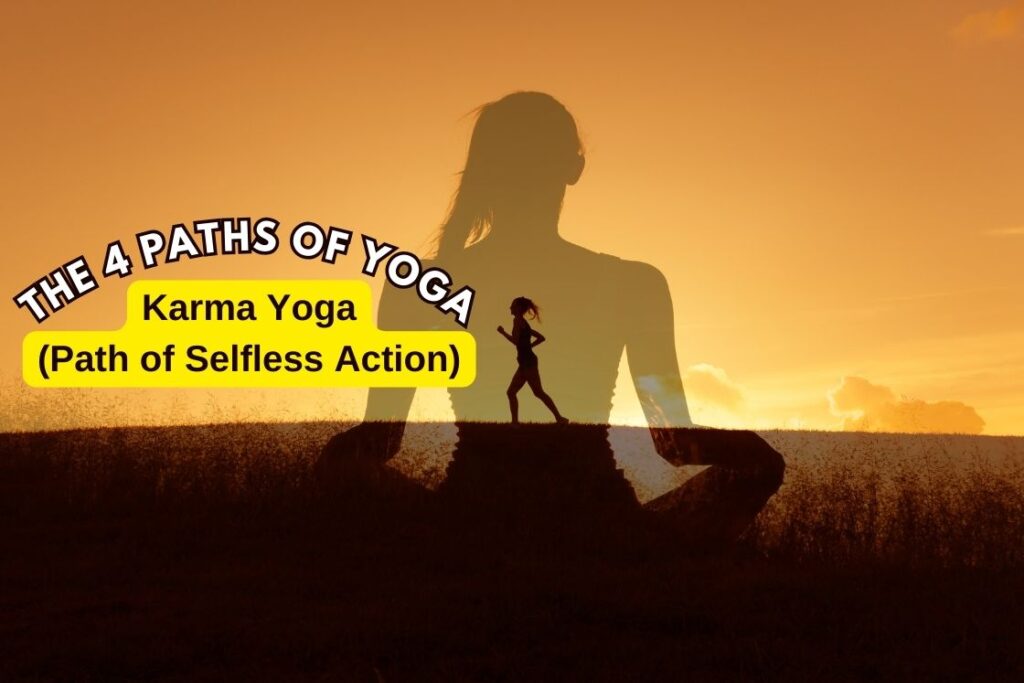
Karma Yoga, also known as the “Path of Selfless Motion,” is likely one of the 4 principal paths of yoga. Rooted within the historical teachings of the Bhagavad Gita, Karma Yoga embodies the follow of selflessly participating in actions with out attachment to outcomes.
This path acknowledges that each one actions in life are interconnected and that by performing one’s duties with dedication and altruism, one can attain non secular development and liberation.
Objective and Essence
The essence of Karma Yoga lies in understanding the idea of karma, which signifies the regulation of trigger and impact. Karma is the accrued results of one’s actions, each good and unhealthy, that influences future experiences. By embracing Karma Yoga, people search to purify their minds and hearts by selflessly dedicating their actions to the next function, usually perceived as service to the Divine or humanity.
Karma Yoga will not be confined to bodily deeds alone; it encompasses psychological actions and intentions as properly. The final word function is to transcend the ego’s attachment to success or failure, achieve or loss, and work with unwavering devotion and equanimity. This path fosters the dissolution of the ego and the cultivation of virtues like selflessness, humility, and compassion.
Origin and Influences
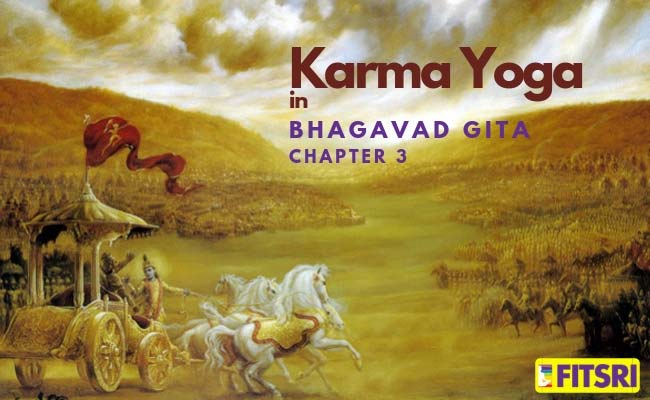
The idea of Karma Yoga finds its roots within the Bhagavad Gita that presents a profound dialogue between Lord Krishna and the warrior Arjuna. Lord Krishna, in his teachings to Arjuna, elucidates the significance of selfless motion and its function in non secular evolution.
Karma Yoga is deeply influenced by the rules of dharma (responsibility), which emphasize the righteous and ethical path in life. It integrates seamlessly with the broader framework of yoga, the place it enhances different paths, reminiscent of Jnana (Data), Bhakti (Devotion), and Raja (Meditation) Yoga.
Alignment with Yoga Philosophy
Karma Yoga aligns with the overarching philosophy of yoga by recognizing that the thoughts, when pushed by egocentric wishes and attachment to outcomes, is a supply of struggling. By participating in selfless actions, people regularly free themselves from the shackles of the ego, decreasing the psychological impurities that obscure the conclusion of their True Self. This path empowers people to transcend the restrictions of the fabric world and transfer nearer to non secular enlightenment.
Karma Yoga in Apply
The follow of Karma Yoga includes performing one’s duties and tasks with none expectation of non-public achieve or recognition. People follow mindfulness of their actions, dedicating their work to the next function or the welfare of others. Service to humanity, acts of kindness, and volunteerism are widespread manifestations of Karma Yoga in each day life.
By frequently providing the outcomes of their actions to the next ultimate or divine precept, practitioners of Karma Yoga domesticate a way of detachment from the fruits of their labor. Over time, this results in a profound transformation of the person, fostering a deep sense of internal peace and self-realization.
Conclusion: Karma Yoga stands as a robust path that teaches us that selfless actions will not be solely a way of serving others but in addition a transformative journey towards non secular awakening. It’s a path of purity, the place people try to purify their hearts and minds, transcending the ego’s limitations, and finally realizing their unity with the Divine. Within the subsequent sections, we are going to discover the opposite three paths of yoga, every providing its distinctive method to self-realization and non secular development.
Jnana Yoga – Path of Data
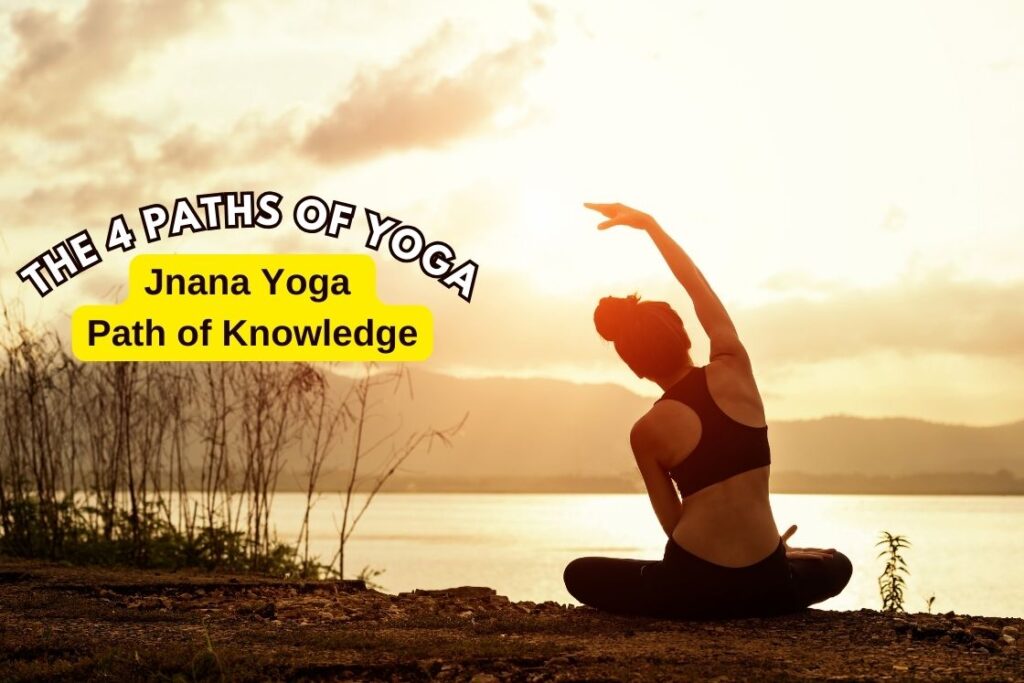
Jnana Yoga, also known as the “Path of Data,” is likely one of the 4 main paths of yoga. Rooted in profound philosophical inquiry, Jnana Yoga encourages seekers to discover the character of actuality, self, and the universe by way of the lens of knowledge and discernment. This path acknowledges that true information is the important thing to liberation and self-realization.
Objective and Essence
The essence of Jnana Yoga lies within the pursuit of self-realization by way of the acquisition of non secular information and knowledge. Practitioners of this path search to transcend the restrictions of the ego-bound self and achieve a deep understanding of their true nature. They acknowledge that the Self (Atman) is equivalent to the Common Consciousness (Brahman) and that this realization results in liberation (moksha).
Jnana Yogis try to discern between the everlasting and the transient, recognizing that the fabric world is impermanent whereas the Self is everlasting and unchanging. The final word function is to get rid of the ignorance (avidya) that veils one’s true id and attain a state of pure consciousness.
Origin and Influences
The roots of Jnana Yoga might be traced again to historical Indian philosophy, notably the Vedanta college of thought. Vedanta asserts that actuality is non-dual (advaita), and the pursuit of information is the means to understand this oneness. Influenced by the Upanishads and different sacred texts, Jnana Yoga integrates these philosophical rules into its follow.
The teachings of Adi Shankaracharya, a outstanding Indian thinker, additional enriched the philosophy of Jnana Yoga. His commentaries on the Upanishads and Advaita Vedanta are famend for his or her depth and readability.
Additionally learn: Advaita Vedanta: The Philosophy of Non-Duality
Alignment with Yoga Philosophy
Jnana Yoga aligns with the broader philosophy of yoga by emphasizing self-inquiry and discernment. It acknowledges that the thoughts, when clouded by ignorance and ego, perpetuates struggling. By delving into the character of actuality and the self, people can dismantle the illusions that bind them and attain a state of liberation.
This path acknowledges that direct expertise and realization of 1’s true nature are the final word objectives of life. It enhances different paths of yoga by offering a basis of knowledge and understanding upon which non secular practices are constructed.
Jnana Yoga in Apply
The follow of Jnana Yoga includes deep self-inquiry, contemplation, and meditation. Seekers have interaction in profound philosophical discussions and research sacred texts to achieve perception into the character of the Self and the universe. They query the very essence of actuality, usually starting with the basic inquiry, “Who am I?”
Discrimination (viveka) is a key side of Jnana Yoga, permitting practitioners to distinguish between the true and the unreal, the everlasting and the transient. They be taught to disidentify from the ego and acknowledge their oneness with the Supreme Actuality.
By cultivating knowledge and self-awareness, Jnana Yogis regularly dissolve the ego’s illusions, resulting in the direct realization of their divine nature.
Conclusion: Jnana Yoga invitations us on a profound journey of self-discovery and knowledge. It emphasizes the significance of transcending ignorance and realizing our true nature as everlasting and unchanging. Within the subsequent sections, we are going to discover the remaining paths of yoga, every providing its distinctive method to non secular development and self-realization.
Bhakti Yoga – Path of Devotion
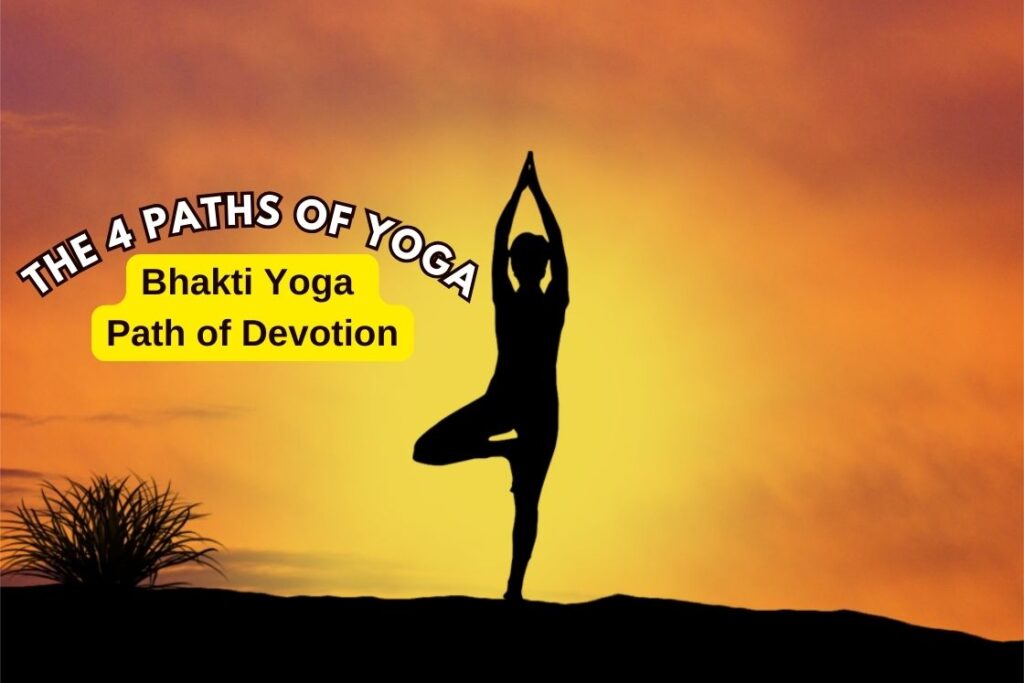
Bhakti Yoga, also known as the “Path of Devotion,” is likely one of the 4 main paths of yoga. Rooted in unwavering love, devotion, and give up, Bhakti Yoga is a heartfelt journey in direction of oneness with the Divine. It acknowledges that the purest type of devotion can result in the final word union with the Supreme.
Objective and Essence
The essence of Bhakti Yoga lies within the cultivation of profound devotion and love for the Divine. Practitioners of this path search to determine an intimate, loving relationship with the Divine, recognizing the presence of the Divine in all facets of existence. The final word function is to transcend the ego and merge with the Divine in a state of pure love and give up.
Bhakti Yogis perceive that the trail of devotion is accessible to all, no matter age, background, or information. It gives a direct and accessible technique of connecting with the Divine and experiencing a way of unity and concord with all of creation.
Origin and Influences
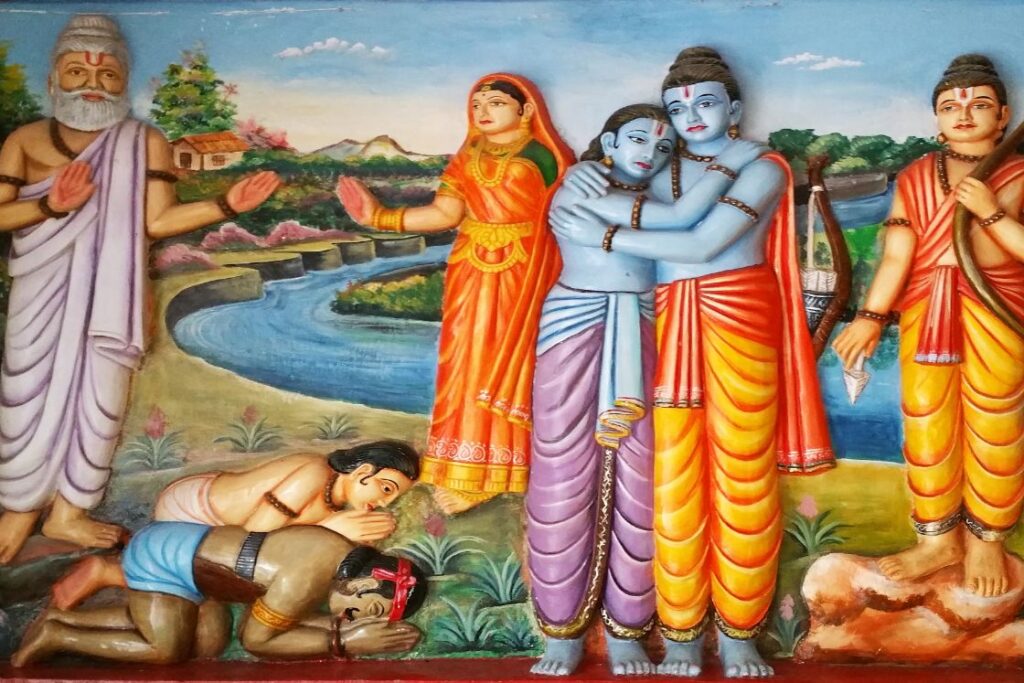
Bhakti Yoga finds its roots in Bhagavad Gita, the Ramayana, and the Bhagavata Purana. These hindu texts emphasize the importance of unwavering devotion to God as a way to achieve non secular realization.
All through historical past, quite a few saints and sages have performed a pivotal function in popularizing and training Bhakti Yoga. Their devotional songs, hymns, and teachings have impressed numerous people to embark on the trail of affection and devotion.
Alignment with Yoga Philosophy
Bhakti Yoga aligns with the broader philosophy of yoga by emphasizing the facility of affection, devotion, and give up as potent instruments for self-realization. It acknowledges that the ego might be transcended by way of the overwhelming power of affection for the Divine.
This path acknowledges that the Divine might be worshiped and approached in varied kinds, be it a private deity, a common power, or the formless Absolute. Bhakti Yoga enhances different paths of yoga by offering a heart-centered basis upon which non secular practices are constructed.
Bhakti Yoga in Apply
The follow of Bhakti Yoga includes acts of devotion, reminiscent of prayer, singing devotional songs (bhajans), and collaborating in rituals and ceremonies devoted to the Divine. Seekers usually select a private deity or type of the Divine that resonates with their hearts.
Central to Bhakti Yoga is the idea of give up (prapatti), the place practitioners relinquish their egoic wishes and belief within the Divine’s will. This give up is marked by unwavering religion and full acceptance of life’s circumstances.
By immersing themselves in acts of affection and devotion, Bhakti Yogis expertise profound states of bliss and ecstasy. They consider that by way of selfless love for the Divine, they will obtain union with the Supreme.
Conclusion: Bhakti Yoga beckons us to embark on a heart-centered journey of devotion and give up. It teaches us that love for the Divine is a transformative power that may result in non secular realization. Within the subsequent sections, we are going to discover the remaining paths of yoga, every providing its distinctive method to non secular development and self-realization.
Raja Yoga – Path of Self-discipline
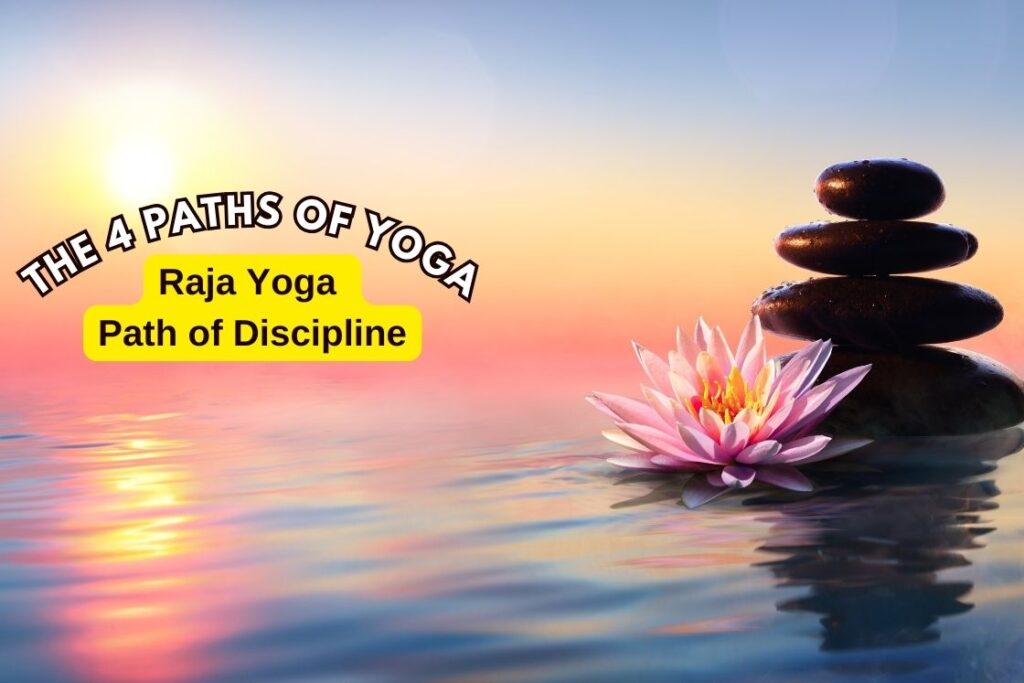
Raja Yoga, also known as the “Path of Self-discipline,” is a complete system of yoga that focuses on the mastery of the thoughts and self-control. Rooted in Patanjali’s Yoga Sutras, this path gives a structured framework for people in search of to achieve internal peace, psychological readability, and non secular realization.
Objective and Essence
The essence of Raja Yoga lies within the meticulous self-discipline and management of 1’s thoughts and senses. It’s a path that results in self-mastery, permitting practitioners to harness the facility of their very own minds to attain non secular awakening. The final word function is to transcend the fluctuations of the thoughts and attain a state of profound internal stillness and realization of the Self.
Raja Yoga teaches that the thoughts is each the supply of struggling and the important thing to liberation. Via disciplined practices, seekers goal to quiet the thoughts’s incessant chatter, overcome distractions, and expertise the pure consciousness that lies beneath the psychological turbulence.
Additionally learn: Is Raja Yoga identical as Ashtanga yoga?
Origin and Influences
Raja Yoga is rooted within the historical teachings of Patanjali, a sage who compiled the Yoga Sutras, a foundational textual content that gives a scientific information to the follow of yoga. Patanjali’s teachings have vastly influenced the event of varied yoga kinds and meditation strategies.
The trail of Raja Yoga has been refined and expanded upon by quite a few non secular leaders and yogic philosophers, making it probably the most extensively practiced types of yoga within the trendy world.
Alignment with Yoga Philosophy
Raja Yoga aligns carefully with the broader philosophy of yoga by emphasizing the significance of psychological and emotional mastery. It acknowledges that the thoughts’s fluctuations (vrittis) are a major impediment to self-realization and internal peace.
This path acknowledges that the thoughts could be a precious software when correctly harnessed and managed. It teaches that by training particular strategies, reminiscent of meditation, focus, and breath management, people can obtain a state of profound internal stability and readability.
Raja Yoga in Apply
Central to Raja Yoga is the follow of meditation (dhyana). Seekers dedicate themselves to common meditation periods, which contain targeted consideration on a selected object, such because the breath, a mantra, or a visible image. Meditation allows people to look at their ideas with out attachment, regularly calming the thoughts’s fluctuations.
One other important element of Raja Yoga is the follow of asana (bodily postures) and pranayama (breath management). These practices assist put together the physique and thoughts for meditation by enhancing bodily flexibility, strengthening the nervous system, and regulating the breath.
The trail of Raja Yoga additionally consists of moral tips (yamas and niyamas) that promote virtuous dwelling, self-discipline, and ethical conduct.
Conclusion: Raja Yoga beckons us to embark on a disciplined journey of self-mastery and psychological management. It teaches us that by way of meditation, asana, and breath management, we will quiet the thoughts’s turbulence and attain a state of profound internal stillness. Within the subsequent part, we are going to discover the idea of mixing these paths and the final word purpose of yoga.
Combining the 4 Paths – Yoga of Synthesis
The journey of self-discovery and non secular awakening by way of yoga doesn’t require unique dedication to a single path. In truth, many practitioners discover that combining components from a number of paths, often called the “Yoga of Synthesis,” can result in a extra holistic and profound yoga expertise.
The Yoga of Synthesis, usually attributed to Swami Sivananda, emphasizes the concept that totally different people have distinctive strengths and inclinations. Whereas one could resonate deeply with the trail of Bhakti Yoga, one other could discover their non secular calling in Raja Yoga or Karma Yoga.
The Yoga of Synthesis encourages practitioners to acknowledge that these paths will not be mutually unique however complementary.
The essence of this method lies within the understanding that every path serves a particular function within the journey towards self-realization. Karma Yoga cultivates selflessness and motion, Jnana Yoga nurtures knowledge and self-inquiry, Bhakti Yoga fosters devotion and love, and Raja Yoga hones psychological self-discipline and meditation. By embracing facets of every path, people can create a extra balanced and built-in follow tailor-made to their distinctive wants and aspirations.
The Yoga of Synthesis permits practitioners to adapt their follow to altering circumstances and life phases. For example, an individual may predominantly observe Karma Yoga throughout lively phases of life, the place selfless service and motion are important. In instances of introspection and self-inquiry, Jnana Yoga could take priority.
The Final Objective of the 4 Paths of Yoga
The follow of yoga, by way of its varied paths, serves a profound function—to steer people towards a state of union, self-realization, and non secular awakening. Whereas the 4 paths of yoga could seem distinct, all of them share a typical purpose: the conclusion of the true self and the final word union with the divine.
Union with the Divine: At its core, the final word purpose of all 4 paths of yoga is to facilitate a deep and transformative union between the person soul (Atman) and the common consciousness (Brahman). This union is also known as self-realization, enlightenment, or Samadhi, and it represents the end result of the yogic journey.
- In Karma Yoga, people dissolve their ego-driven identities by performing selfless actions, finally recognizing their oneness with all of creation.
- Jnana Yoga leads practitioners on an inward journey of self-inquiry, culminating within the realization that they don’t seem to be merely the physique, thoughts, or feelings however the everlasting consciousness itself.
- Bhakti Yoga fosters a profound love and devotion to the divine, finally merging the person soul with the supreme supply of affection and compassion.
- Raja Yoga, by way of meditation and psychological self-discipline, results in the mastery of the thoughts and a direct expertise of the transcendent.
Ananda: The Blissful State: The final word purpose of the 4 paths of yoga is commonly described because the attainment of “Ananda,” which interprets to bliss, pleasure, or supreme happiness. This blissful state will not be contingent upon exterior circumstances however is an inherent high quality of the self-realized soul. It’s a state of profound contentment, peace, and interconnectedness with all of existence.
Ananda arises from the popularity that the restrictions and fluctuations of the person ego are illusions, and the true self is past these fleeting identities. It’s the realization that the person soul is an everlasting spark of the divine, and this recognition brings an unshakable sense of pleasure and success.
Conclusion
In conclusion, the 4 Paths of Yoga—Karma Yoga, Jnana Yoga, Bhakti Yoga, and Raja Yoga—provide various approaches to self-realization and non secular development. Whereas every path has its distinctive rules and practices, all of them finally result in the conclusion of our true nature and union with the divine.
These paths present precious steerage for people in search of internal peace, function, and a deeper understanding of life. Whether or not you select one path or combine components from all, the journey of self-discovery by way of yoga is a profound and transformative expertise. Embrace the trail that resonates with you, and should it lead you to a life crammed with pleasure, love, and non secular success.
FAQs on the 4 Paths of Yoga
The 4 Paths of Yoga are Karma Yoga (Path of Selfless Motion), Jnana Yoga (Path of Data), Bhakti Yoga (Path of Devotion), and Raja Yoga (Path of Self-discipline). Every path gives a definite method to non secular development and self-realization.
Sure, you’ll be able to mix components of various yoga paths to create a follow that aligns along with your non secular journey. Many practitioners discover that facets of a number of paths resonate with them and select to combine these teachings into their lives.
There isn’t any one-size-fits-all reply, as the very best path for you relies on your persona and inclinations. Nevertheless, Bhakti Yoga, the trail of devotion, is commonly thought-about accessible for novices attributable to its emphasis on love and devotion to the next energy.
The final word purpose of all 4 Paths of Yoga is self-realization and union with the divine or common consciousness. It’s the realization that the person soul (Atman) is one with the supreme soul (Brahman) and experiencing a state of boundless pleasure and contentment.
Completely. Your non secular journey is private, and you could discover that your wants and inclinations change over time. Many practitioners begin with one path and later incorporate components from others to deepen their follow.
Whereas having a guru or instructor might be helpful, it’s not obligatory. Many practitioners start their journey by way of self-study and later search steerage from skilled academics. In the end, your sincerity and dedication to your follow are important.
Self-reflection and experimentation are key. Discover every path by studying about them, attending lessons, and attempting out practices related to every path. Take heed to your coronary heart and observe the trail that resonates most deeply with you.
Whereas these paths have deep non secular roots, their rules might be utilized in each day life by anybody in search of private development, internal peace, and a way of function. They provide precious steerage for navigating life’s challenges and discovering that means.
Sure, you’ll be able to combine the teachings and practices of the 4 Paths of Yoga into your each day life with out rigidly following a single path. Many practitioners discover a harmonious mix of those paths enriches their lives.
There isn’t any fastened order, and it relies on your particular person journey. Some could begin with Karma Yoga, whereas others could also be drawn to Bhakti or Jnana Yoga first. Belief your instinct and observe the trail that feels best for you at any given second.

